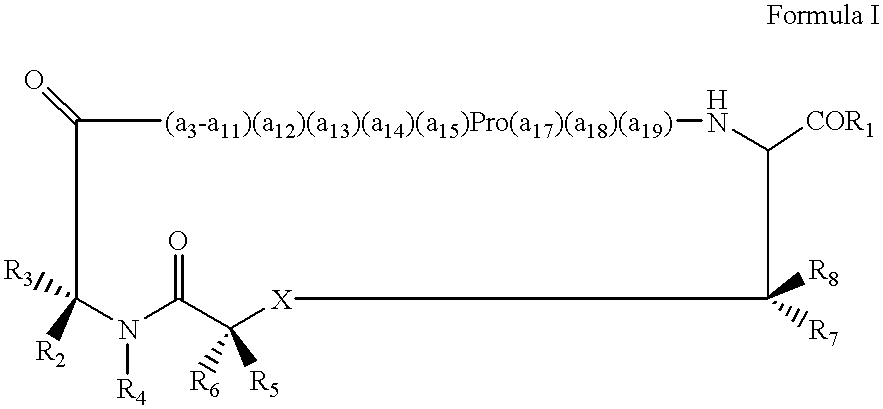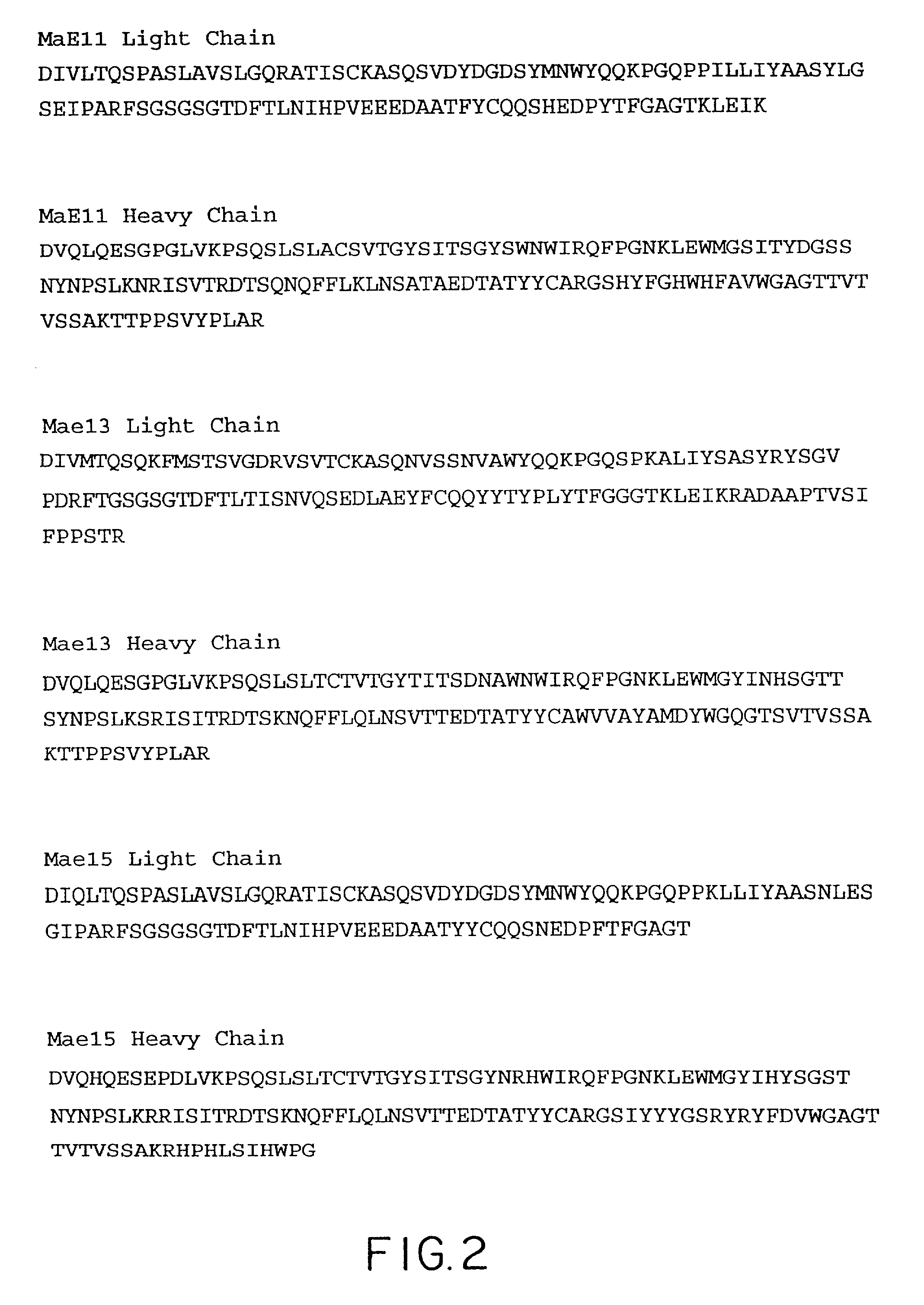Method of treating allergic disorders
a technology of antiige antibodies and amino acids, applied in the direction of antibody medical ingredients, peptides/protein ingredients, peptides, etc., can solve the problems of difficult to eliminate the possibility of non-specific blocking, unclear conclusions, and poorly defined recognition sites of the two receptors
- Summary
- Abstract
- Description
- Claims
- Application Information
AI Technical Summary
Problems solved by technology
Method used
Image
Examples
example 2
Preparation of Variant IgE
[0193] Based on the model of IgE Fc by Padlan & Davies (Mol. Immunol. 23:1063 (1986), which is based on the crystal structure of human IgG1 Fc (Deisenhofer, Biochem. 20:2361-2370 [1981]), a series of mutants were designed which could be used to test the binding of human IgE to its receptors. These mutants are designated Emut 1-13, and are listed in Table 6 below. The Fc.epsilon.3 domain is comprised of seven .beta.-strands which form a .beta.-sheet structure representative of all immunoglobulin domains; there are six loops which connect these seven .beta.-strands. We refer to these loops by the 2 .beta.-strands they connect, e.g. loop AB connects .beta.-stands A and B. We have constructed mutants of human IgE in which we have substituted five of the Fc.epsilon.3 domain loops with their counterparts from human IgG1 (Table 6, 1-5). The sixth loop contains the glycosylation site in both IgE and IgG and hence was not altered. One mutant, (Table 6, 6), was made ...
example 3
Soluble FCEH binding assay
[0196] This assay is a sequential inhibition ELISA which measures binding to the FCEH only. In this assay, a monoclonal antibody against the FCEH is coated onto ELISA plates at a concentration of 1 .mu.g / ml in 50 mM sodium carbonate pH 9.6 for two hours at room temperature, and blocked for two hours with PBS containing 0.5% bovine serum albumin (PBSA), then washed three times with ELISA wash buffer (0.05% Tween 20 in PBS). Recombinantly produced soluble FCEH is added at a concentration of 50 units / ml and incubated for one hour, then washed five times in ELISA wash buffer. Mutant IgE samples are then added to the wells and incubated for one to two hours. The excess mutant IgE is removed by aspiration, and biotinylated IgE is then added at 50 ng / ml for 15 minutes followed by five washes with ELISA wash buffer. Streptavidin conjugated to horseradish peroxidase (Sigma Chemical Company #S5512) was added at a 1:5000 dilution for 15 minutes, then washed three time...
example 4
Preparation of Humanized MaE11
[0206] Residues were selected from MaE11 and inserted or substituted into a human Fab antibody background (V.sub.H region Kabat subgroup III and V.sub.L region kappa subgroup I). A first version, humae11v1 or version 1, is described in Table 8.
10TABLE 8 Changes in V.sub.H human subgroup III and V.sub.L K subgroup I (Kabat) consensus sequences for humanized MaE11 Version 1 Hu Residue CDR CDR Domain Residue No. V.1 by Kabat by Chothia V.sub.L M 4 L Insert 30 abcd YDGD L1 L1 (SEQ ID NO: 26) L* 33 M L1 S 53 Y L2 Y 91 S L3 L3 N 92 H L3 L3 S 93 E L3 L3 L 94 D L3 L3 V.sub.H A 24 V F* 27 Y H1 H1 T 28 S H1 H1 F* 29 I H1 H1 Insert 29a T H1 H1 D 31 G H1 H1 A 33 S H1 H1 M* 34 W H1 H1 V 37 I V 50 S H2 S 52 T H2 N 53 Y H2 H2 G 54 D H2 H2 S 55 G H2 H2 Y 58 N H2 L 78 F D 95 G H3 97-101 All H3 H3 Changed to MaE11 Sequence *These residues typically do not vary despite their position within CDRs. The remaining residues found in the KI and III CDR sequences (particularly t...
PUM
| Property | Measurement | Unit |
|---|---|---|
| Fraction | aaaaa | aaaaa |
| Fraction | aaaaa | aaaaa |
| Fraction | aaaaa | aaaaa |
Abstract
Description
Claims
Application Information
 Login to View More
Login to View More - R&D
- Intellectual Property
- Life Sciences
- Materials
- Tech Scout
- Unparalleled Data Quality
- Higher Quality Content
- 60% Fewer Hallucinations
Browse by: Latest US Patents, China's latest patents, Technical Efficacy Thesaurus, Application Domain, Technology Topic, Popular Technical Reports.
© 2025 PatSnap. All rights reserved.Legal|Privacy policy|Modern Slavery Act Transparency Statement|Sitemap|About US| Contact US: help@patsnap.com



